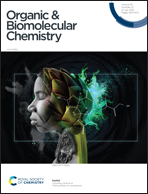Chlorinated metabolites from Streptomyces sp. highlight the role of biosynthetic mosaics and superclusters in the evolution of chemical diversity†
Abstract
LCMS-guided screening of a library of biosynthetically talented bacteria and fungi identified Streptomyces sp. MST-144321 as a prolific producer of chlorinated metabolites. We isolated and characterised six new and nine reported compounds from MST-144321, belonging to three discrete classes – the depsipeptide svetamycins, the indolocarbazole borregomycins and the aromatic polyketide anthrabenzoxocinones. Following genome sequencing of MST-144321, we describe, for the first time, the svetamycin biosynthetic gene cluster (sve), its mosaic structure and its relationship to several distantly related gene clusters. Our analysis of the sve cluster suggested that the reported stereostructures of the svetamycins may be incorrect. This was confirmed by single-crystal X-ray diffraction analysis, allowing us to formally revise the absolute configurations of svetamycins A–G. We also show that the borregomycins and anthrabenzoxocinones are encoded by a single supercluster (bab) implicating superclusters as potential nucleation points for the evolution of biosynthetic gene clusters. These clusters highlight how individual enzymes and functional subclusters can be co-opted during the formation of biosynthetic gene clusters, providing a rare insight into the poorly understood mechanisms underpinning the evolution of chemical diversity.

- This article is part of the themed collection: Chemical Biology in OBC


 Please wait while we load your content...
Please wait while we load your content...